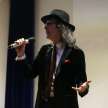On Prince Hal and the History Plays
By Doc Sherwood

William Shakespeare began to write English history plays early in his career with the three-part Henry the Sixth, followed by Richard the Third which was his first major success. Around 1597 he began a second four-part cycle, this one about the preceding historical period.
The first tetralogy had been set in the years 1422 to 1485. The second, which begins with Richard the Second, starts in 1398 and finishes around 1415, thereby bringing these eight English history plays full-circle. Richard the Second was last in a long line of English kings that had ruled since the Norman Conquest of 1066, and Shakespeare saw that the end of his reign would make good drama, just as the War of the Roses had already done. The play Richard the Second therefore chronicles Henry Bolingbroke's successful revolution against his cousin the King, which culminated in Richard's death and Henry's assumption of a crown to which he was not rightful heir.

Shakespeare continued this story in Henry the Fourth, a two-part play dealing with the uprisings Henry still faced from rebels loyal to the memory of King Richard. Most of the interest in Henry the Fourth, however, has focused on the character of King Henry’s eldest son. He is referred to in the dialogue of Richard the Second but makes his onstage debut in Henry the Fourth, Part One. Named Henry after his father, but known as Prince Hal for short, he's one of Shakespeare’s most complicated and fascinating characters.
Frequently described as a “wayward prince,” Hal throughout most of the two Henry the Fourth plays is the despair of his father. Indeed, there's a speech in which King Henry candidly wishes aloud that one of his enemies, a young man nicknamed Harry Hotspur, was his son instead of Prince Hal. This is harsh but perhaps forgivable, since Hotspur is a courteous and highly skilled soldier who behaves as the heir to the throne should, whereas Hal spends his life getting up to mischief with a gang of disreputable cronies.
The worst of these is one of Shakespeare’s most beloved comic characters, Sir John Falstaff. Obese, getting on in years, lecherous, cowardly, a drinker and a petty criminal, we can understand King Henry concerns that his son’s keeping the wrong sort of company. The scenes of knockabout comedy featuring Prince Hal and Falstaff playing practical jokes and insulting each other are in large part the reason Shakespeare’s history plays have remained so popular.
Prince Hal’s reasons for acting the way he does, however, are more complex than his father knows. Early in Henry the Fourth, Part One, Hal’s first soliloquy reveals to the audience that he is only pretending to be friends with Falstaff. His reason is that when his father dies and Hal becomes King, his good qualities will be all the more apparent to a people who remember his unpromising youth. In other words, no matter how warm and comradely Hal’s relations with Falstaff might appear, it’s not a real friendship at all. It’s just a power-play on the part of Prince Hal.
Poor old Falstaff is the last to find this out. In the final scenes of Henry the Fourth, Part Two, Falstaff and his gang are carousing as usual when they learn their old friend has finally been crowned King. They rush to him at once, eager to see what power and riches he’ll grant them in his new reign. But Hal, whose friendship with Falstaff was only ever a lie, cruelly casts him out with the words: “I know thee not, old man.”
Falstaff, though ever greedy for money and comfort, does seem to have genuinely loved Prince Hal and never suspected him of his deception. In the sequel to this play, we learn that Falstaff dies of a broken heart soon after. Henry the Fourth, Part Two boasts arguably the saddest ending in all Shakespeare, not to mention what may be the most despicable deed performed by any of that playwright's so-called heroes.
Nevertheless, hero is what Hal is usually considered to be. As noted above, he succeeds his father as King Henry the Fifth, and is title character of the fourth and final history play in this second cycle. The text dubs him a “star of England,” and certainly he always does what's right in the higher ethical sense. Still however, even to the last, Shakespeare never hesitates to explore the other sides to this character. A man who freely makes use of deceit and cruelty in achieving worthy ends must surely be the strangest hero of all.
About the Creator
Reader insights
Outstanding
Excellent work. Looking forward to reading more!
Top insights
Compelling and original writing
Creative use of language & vocab
Easy to read and follow
Well-structured & engaging content
Expert insights and opinions
Arguments were carefully researched and presented
Eye opening
Niche topic & fresh perspectives
On-point and relevant
Writing reflected the title & theme






Comments (2)
Excellent story!!!
Wow! Another in-depth analysis of Shakespeare's historical plays, while brilliantly offering insights into the plots and complexities of the characters within them. Delves into the historical context and the intricate relationships between the characters, particularly focusing on Prince Hal and his complex portrayal, gives it a new perspective. The way you highlighted the depth of Shakespeare's characters as well as their flaws and ethical dilemmas makes it an informative and thought-provoking read. Really enjoyed it.